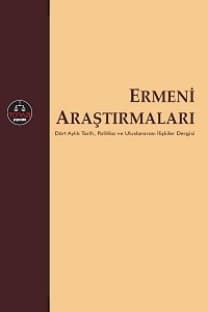İNŞACI KURAM GÖZÜYLE ULUSAL KİMLİK, İKİLİ İLİŞKİLER VE UZLAŞMA
İnşacı Kuram’a göre genel olarak kimlikler ve özelinde ulusal kimliklersosyal birer kurgudur ve zaman içerisinde inşa edilirler. İnşa edilen ulusalkimlikler dış politikayı etkilemekte, belirlemekte ve diğer taraftan iletişimsüreçlerinde kendisi de değişmekte ve yeniden şekillenmektedir. 1915olayları Türk ve Ermeni taraflarının ulusal kimliklerinin bir parçası olarakyer bulmuş ve özellikle Ermeni ulusal kimliğinde merkezi bir konumedinmiştir. Bu çerçevede inşa edilmiş olan ulusal kimlikler ikili ilişkilerisınırlayıcı niteliktedir. İkili ilişkiler başlatılmadıkça mevcut kimlik algısımuhafaza edilmektedir. Yeni bir dış politika ve çözüm süreçlerininbaşlatılması barışçı komşuluk ilişkileri için gereklidir, fakat bunlar büyükadımlar olsa da yeterli olmayacaktır. Mevcut kimlikler ikili ilişkileri o denlidışlayıcıdır ki kalıcı barışın sağlanabilmesi için önce çözüm süreçlerinin,sonrasında ise daha geniş bir niteliğe sahip olan uzlaşma süreçlerininbaşlatılması gerekmektedir. Bu uzlaşma süreçlerinde siyasi ve hukukiçözümlere ihtiyaç duyulduğu kadar tutumlarda ve kimlik algısındakideğişimler de önem arz etmektedir
Anahtar Kelimeler:
Türk-Ermeni İlişkileri, 1915 Olayları, İnşacı Kuram Ulusal Kimlik
(NATIONAL IDENTITY, BILATERAL RELATIONS AND RECONCILIATION FROM THE CONSTRUCTIVIST PERSPECTIVE)
According to constructivist theory; identities in general andnational identity in specific are social constructs and they are constructedthroughout time. On the one hand, the constructed national identitiesinfluence and determine foreign policy. While on the other hand, asembedded in communication processes, they also change and are reshaped.The events of 1915 are an inherent part of both Armenian and Turkishnational identities. These events especially occupy a central place inArmenian identity. National identities built within this framework have aquality such that they put constraints on bilateral relations. Withoutlaunching bilateral relations, existing identity perceptions are maintained.Entering into bilateral relations and resolution process is necessary for thepeaceful neighborhood. Although the large steps show significantdevelopment, they do not yet suffice. Present identities are so exclusive thatattaining a lasting peace requires the initiation of the resolution processes, andafter which of a reconciliation processes. The reconciliation processesnecessitate the political and legal resolutions as much as fundamental changesin attitudes and identity perceptions
___
- Ackerman, B., The Future of Liberal Revolution (New Haven, CT: Yale University Press, 1992).
- Adler, E., ‘Seizing the Middle Ground: Constructivism and World Politics’, European Journal of International Relations, Cilt 3, Sayı 3, 1997.
- Akçam, T., Türk Ulusal Kimliği ve Ermeni Sorunu, Beşinci Baskı (İstanbul: Su Yayınları, 2001).
- Bauman, Z., ‘Soil, Blood and Identity’, Sociological Review, Cilt 40, Sayı 4, Kasım 1992.
- Bloom, W., Personal Identity, National Identity, and International Relations (New York: Cambridge University Press, 1990).
- Cleveland, W., M. Bunton, A History of the Modern Middle East, Fourth Edition (Philadelphia: Westview Press, 2009).
- Çoban-Öztürk, E., ‘Diaspora ve Dış Politika: Türkiye-Ermenistan İlişkilerinde Diasporanın Rolü’, Ermeni Araştırmaları, Sayı 45, 2013.
- Doty, R., ‘Sovereignty and the Nation: Constructing the Boundaries of National Identity’, T. J. Bierstecker ve C. Weber, (der.), State Sovereignty as Social Construct (New York: Cambridge University Press, 1996).
- Göçek, F. M., ‘Reconstructing the Turkish Historiography on the Armenian Massacres and Deaths of 1915’, R. G. Hovannisian, (der.), Looking Backward, Moving Forward: Confronting the Armenian Genocide (New Brunswick: Transaction Publishers, 2006).
- Grad, H., L. M. Rojo, ‘Identities in Discourse: An Integrative View’, R. Dolon, J. Todoli, (der.), Analysing Identities in Discourse (Amsterdam, Philadelphia: John Benjamins Publishing Company, 2008).
- Griffiths, M., S. C. Roach, M. S. Solomon, Uluslararası İlişkilerde Temel Düşünürler ve Teoriler, Çeviren, CESRAN (Ankara: Nobel Yayınevi, 2011).
- Katzenstein, P., ‘Introduction: Alternative Perspectives on National Security’, P. Katzenstein, (der.), The Culture of National Security: Norms and Identity in World Politics (New York: Columbia University Press, 1996).
- İnşacı Kuram Gözüyle Ulusal Kimlik, İkili İlişkiler ve Uzlaşma 100 Yrd. Doç. Dr. Ebru ÇOBAN ÖZTÜRK
- Ermeni Araştırmaları 2014, Sayı 47
- Laçiner, S., Ermeni Sorunu, Diaspora ve Türk Dış Politikası: Ermeni İddiaları Türkiye’nin Dünya ile İlişkilerini Nasıl Etkiliyor? (Ankara: USAK Yayınları, 2008).
- MacDonald, D. B., Identity Politics in the Age of Genocide: The Holocaust and Historical Representation (New York: Routledge, 2008).
- Miller, D. E., L. Touryan Miller, ‘Memory and Identity Across the Generations’, A Case Study of Armenian Survivors and Their Progeny’, Qualitative Sociology, Cilt 14, Sayı 1, 1991.
- Pattie, S. P., ‘Armenians in Diaspora’, E. Herzig, M. Kurkchiyan, (der.), The Armenians Past and Present in the Making of National Identity (London and New York: Routledge, 2005).
- Phillips, J., Symbol, Myth, and Rhetoric: The Politics of Culture in an Armenian-American Population (New York: AMS Press, 1989).
- Shain, Y., A. Barth, ‘Diasporas and International Relations Theory’, International Organization, Cilt 57, Sayı 3, Yaz 2003.
- Staub, E., ‘Healing and Reconciliation’, R. G. Hovannisian, (der.), Looking Backward, Moving Forward: Confronting the Armenian Genocide (New Jersey: Transaction Publishers, 2003).
- Üngör, U. Ü., ‘Seeing like a nation-state: Young Turk social engineering in Eastern Turkey, 1913-50’, Journal of Genocide Research, Cilt 10, Sayı 1, 2008.
- Verdeja, E., Unchopping a Tree: Reconciliation in the Aftermath of Political Violence (Philadelphia: Temple University Press, 2009).
- Wendt, A. E., ‘Anarchy Is What States Make of It: The Social Construction of Power Politics’, F. Kratochwil ve E. D. Mansfield, (der.), International Organization: A Reader (New York: Harper Collins, 1994).
- Wendt, A. E., ‘Collective Identity Formation and the International State’, American Political Science Review, Cilt 88, 1994.
- Wendt, A. E., Social Theory of International Politics (Cambridge: Cambridge University Press, 1999).
- Whittaker, D. J., Conflict and Reconciliation in the Contemporary World (London and New York: Routledge, 1999), s. 1-9.
- Ermeni Araştırmaları 101 2014, Sayı 47
- Wodak, R., R. de Cillia, M. Reisigl and K. Liebhart, The Discursive Construction of National Identity, Translated by, A. Hirsch, R. Mitten, J. W. Unger, Second Edition (Edinburgh: Edinburgh University Press, 2009).
- Zehfuss, M., Constructivism in International Relations: The Politics of Reality (Cambridge: Cambridge University Press, 2004).
- Zehfuss, M., ‘Constructivism and identity: a dangerous liaison’, S. Guzzini, A. Leander, (der.), Constructivism and International Relations: Alexander Wendt and His Critics (London, New York: Routledge, 2006).
- Zürcher, E. J., Milli Mücadelede İttihatçılık, Çeviren, N. Salihoğlu, Altıncı Baskı (İstanbul: İletişim Yayınları, 2010).
- ISSN: 1303-068X
- Yayın Aralığı: Yılda 2 Sayı
- Başlangıç: 2001
- Yayıncı: Avrasya İncelemeleri Merkezi
